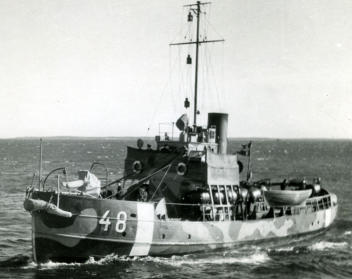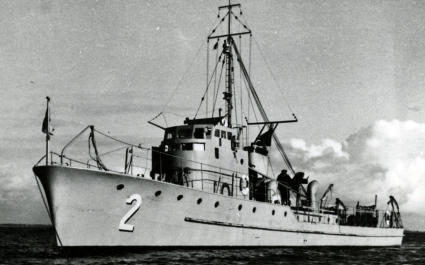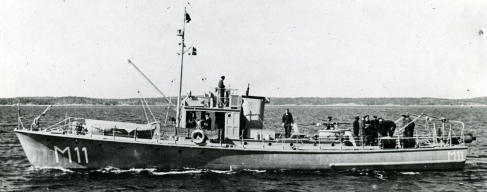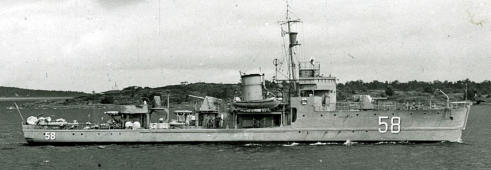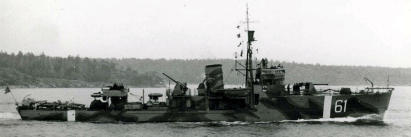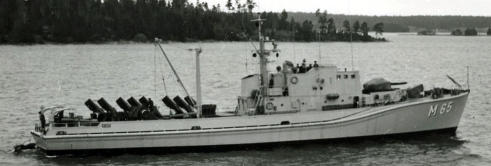

Copyright © Hans Högman 2023-10-02
Ships of the Swedish Navy - 8
Swedish Warships - Surface
Combatants - 7
List of various types of Swedish Motorized
Surface Combatants
•
Battleship
•
Coastal defense ship
•
Cruiser, part-1, part-2
•
Destroyer, part-1, part-2, part-3
•
Frigate
•
Corvette
•
Motor torpedo boat
•
Torpedo boat / Missile boat
•
Patrol boat
•
Picket boat
•
Surveillance boat
•
Minelayer / Minehunter / Minesweeper
Definitions
In the description of the ships, there are some
concepts and terms that may be worth describing.
•
Pennant No., the recognition number that
Swedish warships normally, in peacetime, have
painted on the side of certain types of ships. For
submarines, it is an abbreviation of the
submarine's name. [Hull No. in the US].
•
Delivered refers to the time when the ship was
formally delivered to the Navy from the shipyard.
•
Launched, refers to the time when the ship was
christened and launched.
•
Decommissioned normally refers to the time
when the ship is permanently removed from the
Navy organization.
•
Displacement, expressed in tons, is given with two
values, standard displacement, and displacement
when the ship is fully equipped. If only one value is
given, it refers to standard displacement. For
submarines, displacement is given in surface
mode and submerged mode.
•
Speed is given in knots and refers to the
contracted speed. For submarines, the speed is
given in surface mode and submerged mode.
•
Dimensions, given in meters for length, beam,
and draft. The length may be given in two
dimensions: the waterline and the maximum
overall length. If only one length is given, the
maximum length is referred to. Beam means the
maximum width.
•
Complement, the crew size. It normally refers to
the peacetime crew size.
•
Submarine diving depths indicate the maximum
permitted diving depth in peacetime.
•
ihp = Indicated horsepower (the theoretical
power of a reciprocating engine if it is completely
frictionless)
The abbreviation "HMS" means “Hans Majestäts Skepp
/ Hennes Majestäts Skepp” and is used in the Swedish
Navy as a prefix before the ship's name, such as HMS
Visby. However, HMS was not used by the Swedish
Navy until after 1950. For older ships, i.e. built before
1950, "HM" (His Majesty's) was used followed by the
ship type and name, e.g. HM Kryssare Tre Kronor.
HSwMS is a sometimes used designation for military
ships from Sweden when traveling outside Sweden's
territorial waters, instead of HMS.
In the UK, the same abbreviation stands for Her
Majesty's Ship or His Majesty's Ship and has been used
in the Royal Navy since the 1660s. The USA uses the
designation USS, United States Ship.
During WW II, from June 23, 1940, Swedish warships
were marked with white transverse lines on their
decks and sides so that they could be clearly
identified as neutral ships and thus avoid accidental
fire from the belligerents.
Minesweeper
Minesweepers are small warships that tow mine
clearance devices, known as "sweeps", for disabling
mines. Classic contact mines, which are moored to the
bottom and float just below the surface of the water,
are cleared by minesweepers dragging a sweep wire
behind them that cuts the mine's anchor lines. The
Second World War saw the introduction of magnetic
mines, naval mines that explode when a steel ship
disturbs the earth's magnetic field. This type of mine
is cleared by a wooden or plastic minesweeper towing
a magnetic float (so-called “pig”) behind it.
Swedish Minesweepers
There were no minesweepers specifically built for
minesweeping in the Swedish Navy before the First
World War. Instead, older torpedo boats and other
smaller vessels were used for this task before the war.
These boats had then been extra equipped for
minesweeping.
Our first proper minesweepers and their equipment
were acquired at the end of the First World War (1917-
1918). They were 3 Sökaren class minesweepers.
In the early 1930s, 4 Jägaren class picket boats with
minesweeping capacity were acquired. However, the
vessels had some limitations as minsweepers. In
1935, 2 Norwegian whalers (Styrbjörn class) were
purchased and used to train auxiliary minesweeper
crews. In the Swedish Navy they were named HMS
Starkodder (51) and HMS Styrbjörn (52).
It was not until 1937 that 2 ship types were acquired
that met all the requirements for functional
minesweeping. They were HMS Arholma and HMS
Landsort, and M1 and M2.
The Swedish Navy has traditionally invested heavily in
good mine clearance capabilities, both by developing
mine technology and clearance methods.
Sökaren class minesweeper:
The Sökaren class was a series of 3 minesweepers
consisting of the ships HMS Sökaren (47), HMS
Sveparen (48), and HMS Sprängaren (49). They were
acquired with funds left over from the 1912 Coastal
Defense Ship Collection.
The first two were launched in 1917, the Sprängaren
in 1918. All 3 were delivered to the Navy in 1918.
The boats were initially referred to as picket boats, but
they were our first ships that were built for
minesweeping from the outset and were equipped
with minesweeping equipment. They were also
equipped with mine rails for mine laying. From 1930,
the ships were called tenders as they were better
suited for use as auxiliary vessels.
1.
HMS Sökaren (16 / 47), launched in 1917 and
delivered to the Navy in 1918.
Decommissioned in 1953.
2.
HMS Sveparen (17 / 48), launched in 1917 and
delivered to the Navy in 1918. Decommissioned
in 1964.
3.
HMS Sprängaren (18 / 49), launched in 1917
and delivered to the Navy in 1918.
Decommissioned in 1962.
The vessels were 27.8 m long and the beam was 7 m.
Displacement 232 tons. Speed: 10 knots.
Complement: 16 men.
The machinery consisted of a 2-cylinder standing
compound steam engine (piston steam engine) and a
Howden water tube boiler. 400 ihp. 1 propeller. They
were armed with a 57 mm cannon m/16. It was later
supplemented with a 25 mm automatic cannon and a
machine gun.
The image shows the minesweeper HMS Sprängaren
48, launched in 1918, delivered to the navy in 1918.
Length 27.8 m, beam 7 m. Image: Maritime History
Museum, ID: Fo200072.
Before 1940, these ships were numbered HMS
Sökaren (16), HMS Sveparen (17), and HMS
Sprängaren (18). Thereafter, 47, 48, and 49.
The Sökaren was decommissioned in 1953, the
Sveparen in 1964, and the Sprängaren in 1962. The
Sökaren ran aground in October 1953 in
Baggensfjärden near Saltsjöbaden (Stockholm
archipelago) and sank.
Styrbjörn class minesweeper:
The Styrbjörn class consisted of two former
whaling ships acquired from Norway in 1935. In the
Swedish Navy, they were named HMS Starkodder
(51) and HMS Styrbjörn (52). As Norwegian whaling
ships, they were named Graham and Klo. The ships
were acquired for training the wartime crews of the
auxiliary picket boats and were equipped with an
older 37 mm m/98B cannon, which was replaced in
1940-1941 by a more modern 20 mm m/40 anti-
aircraft automatic gun. They were also equipped with
the m/34 protective sweep.
Initially, they had bow numbers 1 and 2, but during
the war, they were given the numbers 51 and 52
respectively. Both ships were part of the Gothenburg
Squadron during the war and served around the
Swedish west coast. They were very seaworthy and
were used during the war for patrolling, but were also
used for mine laying and icebreaking.
In 1948 the ships were reclassified as tenders.
•
HMS Starkodder (1 / 51), launched in 1925 in
Norway, in Swedish service from 1935.
Decommissioned in 1959.
•
HMS Styrbjörn (2 / 52), launched in 1923 in
Norway, in Swedish service from 1935.
Decommissioned in 1959.
The Starkodder was 35.4 m long and the beam was 7.0
m. Displacement 375 tons. Speed: 12 knots.
Complement: 12 men.
The Styrbjörn was 32.6 m long and the beam was 6.7
m. Displacement 350 tons. Speed: 12 knots.
Complement 12 men.
The machinery consisted of a 3-cylinder triple-
expansion steam engine, 750 ihp. One fire tube boiler.
1 propeller.
The armament was a 37 mm cannon m/98B (later a
20 mm anti-aircraft automatic gun m/40), and one 8
mm machine gun m/36.
The image shows the minesweeper HMS Starkodder
(51), launched in 1925 in Norway, purchased by the
Swedish Navy in 1935. Length 35.4 m, beam 7 m.
Photo in 1944. Image: Maritime History Museum, ID:
Fo83454A.
Minesweepers M1 and M2:
Two prototype mine sweeping ships were built in steel
in 1937, HMS M1 and HMS M2. The experimental
vessels were shallow-draft 30 m long minesweepers
for mine clearance in narrow and shallow channels
and bays that required good maneuverability. They
were equipped with 3 propellers.
•
HMS M1 (1), launched in 1937 and delivered to the
Navy in 1938. Decommissioned in 1952.
•
HMS M2 (2), launched in 1937 and delivered to the
Navy in 1938. Decommissioned in 1953.
The vessels were 30.7 m long and the beam was 4.3
m. Displacement 61 tons. Speed: 18 knots.
Complement: 13 men.
The machinery on the M1 consisted of three 600 hp
Ellwe diesel engines with 3 propellers.
The machinery on the M2 consisted of three
NOHAB-Hellelman diesel engines of 630 hp. 3
propellers.
The armament consisted of a dual 8 mm machine
gun m/36 and depth charges. During the war, the
machine gun was replaced by a 40 mm automatic
cannon m/40. At that time the ships were not
primarily used for mine sweeping but for mine
reconnaissance and mine destruction.
The image shows the minesweeper M2, launched in
1937, delivered to the Navy in 1938. Length 30.7 m,
beam 4.3 m. Image: Maritime History Museum, ID:
Fo56193A.
Minsweepers of the M3 class / the 39-boats
(Minsweepers less):
After the experiences with the M1 and M2 but
especially with the fish transport vessel / auxiliary
picket vessel HMS Axel 385 (designed by Jac Iversen)
from 1934 as a model, a series of 12 minesweepers
were built between 1939 and 1940 in wood (Honduras
mahogany except for the M13 which was built in oak).
They were the HMS M3 - HMS M14.
The class was called the 39-boats, referring to the
year of ordering (1939). The ships were equipped with
KaMeWa propellers and had very good
maneuverability. On these 39-boats, the mast is
located forward of the wheelhouse, while on the
following 40-boats, it is located aft of the funnel.
The vessels in the class:
1.
HMS M3, launched in 1940 and delivered to the
Navy in 1940. Decommissioned in 1955.
2.
HMS M4, launched in 1940 and delivered to the
Navy in 1941. Decommissioned in 1955.
3.
HMS M5, launched in 1940 and delivered to the
Navy in 1940. Decommissioned in 1955.
4.
HMS M6, launched in 1940 and delivered to the
Navy in 1941. Decommissioned in 1955.
5.
HMS M7, launched in 1940 and delivered to the
Navy in 1940. Decommissioned in 1959.
6.
HMS M8, launched in 1941 and delivered to the
Navy in 1941. Decommissioned in 1959.
7.
HMS M9, launched in 1940 and delivered to the
Navy in 1940. Decommissioned in 1960.
8.
HMS M10, launched in 1940 and delivered to the
Navy in 1941. Decommissioned in 1960.
9.
HMS M11, launched in 1940 and delivered to the
Navy in 1940. Decommissioned in 1957.
10.
HMS M12, launched in 1941 and delivered to the
Navy in 1941. Decommissioned in 1957.
11.
HMS M13, launched in 1940 and delivered to the
Navy in 1941. Decommissioned in 1959.
12.
HMS M14, launched in 1941 and delivered to the
Navy in 1941. Decommissioned in 1959.
The vessels were 25 m long and the beam was 5.1 m.
Displacement 51 tons. Speed: 13 knots. Complement:
12 men.
The machinery consisted of two 400 hp Bolinder-
Munktell diesel engines for the M3 - M6. The M7-M14
(except for M8) had two 400 hp Ellwe diesel engines.
The M8 had two Scania D815 diesel engines of 396 hp.
2 propellers.
They were armed with a 20 mm anti-aircraft
automatic gun m/40 and an 8 mm machine gun m/36
(not all ships).
The ships were decommissioned between 1955 and
1960.
The image shows the minesweeper HMS M11 (39-
boats), launched in 1940, delivered to the Navy in
1940. Length 25 m, beam 5.1 m. Image: Maritime
History Museum, ID: Fo24136.
Minesweepers of the M15 class / the 40-boats
(Minesweepers less):
Between 1941 and 1942, another 12 minesweepers,
the HMS M15 - HMS M26, were built and played a
major role in Swedish coastal defense. The ship class
is M15. The class was called the 40-boats, referring to
the year of order (1940). The 40-boats were very
similar to the 39-boats. On the 39-boats, the mast is
located in front of the wheelhouse, while on the 40-
boats it is located behind the funnel. From the outset,
the 40-boats had an open maneuvering area at the
stern of the bridge.
The vessels in the class:
1.
HMS M15, launched in 1941 och delivered to the
Navy in 1941. Decommissioned in 1984.
2.
HMS M16, launched in 1941 and delivered to the
Navy in 1941. Decommissioned in 1984.
3.
HMS M17, launched in 1941 and delivered to the
Navy in 1941. Decommissioned in 1986.
4.
HMS M18, launched in 1941 and delivered to the
Navy in 1941. Decommissioned in 1986.
5.
HMS M19, launched in 1941 and delivered to the
Navy in 1942. Decommissioned in 1965.
6.
HMS M20, launched in 1941 and delivered to the
Navy in 1941. Decommissioned <2005.
7.
HMS M21, launched in 1941 and delivered to the
Navy in 1942. Decommissioned in 2007.
8.
HMS M22, launched in 1941 and delivered to the
Navy in 1941. Decommissioned in 2004.
9.
HMS M23, launched in 1941 and delivered to the
Navy in 1941. Decommissioned in 1989.
10.
HMS M24, launched in 1941 and delivered to the
Navy in 1941. Decommissioned in 2005.
11.
HMS M25, launched in 1941 and delivered to the
Navy in 1941. Decommissioned in 2004.
12.
HMS M26, launched in 1941 and delivered to the
Navy in 1941. Decommissioned in 1989.
The vessels were 27.7 m long and the beam was 5 m.
Displacement 70 tons. Speed: 12 knots. Complement:
12 men.
The machinery consisted of two Frich full diesel
engines, 400 hp. 2 propellers. They were armed with
a 20 mm anti-aircraft automatic gun m/40 and an 8
mm machine gun m/36 (not all ships due to delivery
problems). The 20 mm gun was originally equipped
with a dome, but it was replaced during the war with a
steel plate that provided better shrapnel and wind
protection.
Both the 40-boats and the 39-boats were heavily used
during the war as minesweepers and mine disposal
units, as well as in the post-war minesweeps.
The minesweeper M20 is preserved as a museum
ship, owned by the Maritime History Museum but
managed and operated since 2005 by the M20
Association.
The image shows the minesweeper HMS M15 (40-
boat), launched in 1941, delivered to the Navy in 1941.
Length 27.7 m, beam 5 m. Photo August 1951, image:
Maritime History Museum, ID: Fo193007.
Arholma class minesweepers (Minesweepers
larger):
The Arholma class was a series of 14 (2+6+6) steel
minesweepers built between 1937 and 1940, which
were rapidly built during World War II. HMS Arholma
(53) and HMS Landsort (54) were launched as early as
1937. In 1939 it was decided that six more ships
would be built. In 1940, the decision was made to
build yet another six ships in the class. All 12 ships
were launched between 1940 and 1941.
For its size, the Arholma class was heavily armed and can
be compared to the coastal destroyers of the time. The
last six ships were also adapted for naval cadet
training.
The ships were: HMS Arholma (53), HMS Landsort (54),
HMS Bremön (55), HMS Holmön (56), HMS Sandön (57),
HMS Ulvön (58), HMS Bredskär (59), HMS Grönskär (60),
HMS Ramskär (61), HMS Örskär (62), HMS Koster (63),
HMS Kullen (64), HMS Vinga (65), and HMS Ven (66).
During World War II, the Arholma-class minesweepers
were widely used and formed a very important part of
the Swedish neutrality watch.
The The image shows the minesweeper HMS
Ramskär (61), launched in 1940, delivered to the
Navy in 1941. Length 56.7 m, beam 7.6 m. Photo
between 1941 and 1945. Image: Maritime History
Museum, ID: Fo70447AF.
The ships in the class:
1.
HMS Arholma (53), launched in 1937 and
delivered to the Navy in 1939. Decommissioned
in 1960.
2.
HMS Landsort (54), launched in 1937 and
delivered to the Navy in 1939. Decommissioned in
1964.
3.
HMS Bremön (55), launched in 1940 and
delivered to the Navy in 1940. Decommissioned in
1966.
4.
HMS Holmön (56), launched in 1940 and
delivered to the Navy in 1940. Decommissioned in
1964.
5.
HMS Sandön (57), launched in 1940 and delivered
to the Navy in 1941. Decommissioned in 1964.
6.
HMS Ulvön (58), launched in 1941 and delivered
to the Navy in 1941. Decommissioned in 1968.
7.
HMS Bredskär (59), launched in 1940 and
delivered to the Navy in 1941. Decommissioned in
1966.
8.
HMS Grönskär (60), launched in 1940 and
delivered to the Navy in 1941. Decommissioned in
1963.
9.
HMS Ramskär (61), launched in 1940 and
delivered to the Navy in 1941. Decommissioned in
1966.
10.
HMS Örskär (62), launched in 1941 and
delivered to the Navy in 1941. Decommissioned in
1966.
11.
HMS Koster (63), launched in 1940 and
delivered to the Navy in 1941. Decommissioned in
1964.
12.
HMS Kullen (64), launched in 1940 and
delivered to the Navy in 1941. Decommissioned in
1966.
13.
HMS Vinga (65), launched in 1940 and delivered
to the Navy in 1940. Decommissioned in 1964.
14.
HMS Ven (66), launched in 1940 and delivered to
the Navy in 1941. Decommissioned in 1959.
The vessels were 56.7 m long and the beam was 7.6
m. Displacement 460 tons. Speed: 18 knots.
Complement: 46 men.
The machinery consisted of two de Laval steam
turbines of 1,600 hp each, two oil boilers type
Normand. 2 propellers.
The armament was two 10.5 cm guns m/40 (the
Arholma, Landsort, and some others initially had two
7.5 cm guns m/05 or m/12 due to delivery problems),
a dual 25 mm anti-aircraft automatic gun m/32, two 8
mm machine guns m/36, 40 naval mines, two depth
charge dispensers, two depth charge launchers, and
24 depth charges. All ships were successively rearmed
with the 10.5 cm guns.
The ships were also equipped with magnetic loops on
the outside. Gradually they were also equipped for
anti-submarine warfare, including the installation of a
simple high-frequency sonar.
A major modernization began in 1948, with a
modern 40 mm m/48 cannon replacing the dual 25
mm gun. Later, the original 10.5 cm gun was replaced
by a 57 mm illumination shell launcher. The number
of depth charges was increased to 51. Combat
management and navigation equipment were
modernized. In the early 1950s, ships were equipped
with modern hydrophones.
The ships were decommissioned between 1959 and
1966.
HMS Bremön (55) was handed over to the Naval
Museum in Karlskrona in 1987 and is now moored at
Stumholmen.
The image shows the minesweeper HMS Ulvön (58),
launched in 1941, delivered to the Navy in 1941.
Length 56.7 m, beam 7.6 m. Photo in 1948. Image:
Maritime History Museum, ID: Fo88509AB.



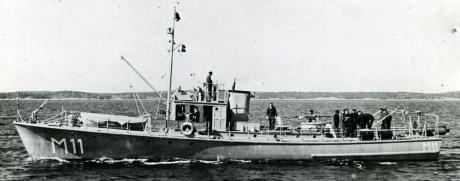
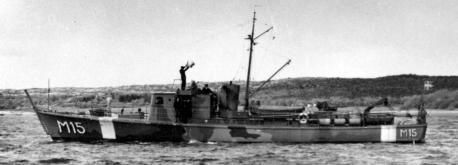


Minesweepers of the Hanö class:
The Hanö class consisted of a series of 6
minesweepers, M51 - M56, delivered to the Navy in
the early 1950s. The ships were initially intended to be
built of wood, but in the end, steel was chosen. They
were equipped with KaMeWa propellers (Swedish-
designed propellers).
The image shows the minesweeper HMS Utö (M56),
launched in 1952, delivered to the Navy in 1953.
Length 42 m, beam 7 m. Photo 1960-1970s. Image:
Marinmuseum, ID: B35:20.
The ships in the class:
1.
HMS Hanö (M51 / V51), launched in 1952 and
delivered to the Navy in 1953. Decommissioned
in 1982.
2.
HMS Tärnö (M52 / V52), launched in 1952 and
delivered to the Navy in 1953. Decommissioned in
1988.
3.
HMS Tjurkö (M53 / V53), launched in 1951 and
delivered to the Navy in 1953. Decommissioned in
1992.
4.
HMS Sturkö (M54 / V54), launched in 1952 and
delivered to the Navy in 1953. Decommissioned in
1987.
5.
HMS Ornö (M55 / V55), launched in 1952 and
delivered to the Navy in 1953. Decommissioned in
1993.
6.
HMS Utö (M56 / V56), launched in 1952 and
delivered to the Navy in 1953. Decommissioned in
1982.
The vessels were 42.0 m long and the beam was 7.0
m. Displacement 275 tons. Speed: 14.5 knots.
Complement: 25 men.
The machinery consisted of two Nohab diesel
engines with a total of 910 hp. 2 propellers. The
armament consisted of two 40 mm anti-aircraft
automatic guns m/48. The two 40 mm pieces were
gradually fitted with plastic domes. The magnetic
mine protection consisted of magnetic loops fitted on
the outside. Later, the ships were equipped with m/55
illumination shell launchers. In the 1960s, a so-called
fishing astic (hydrophone 105 of fiskeastic type) was
added as a mine detector and for monitoring
submarines.
Around 1965, the ships were reclassified as picket
boats and were then given the designations V51 - V56
(Source: Hofsten). Some sources indicate that the
reclassification took place only in 1979.
HMS Hanö served from 1955 to 1976 as an auxiliary
vessel for the Icelandic fishery and from 1962 also for
the North Sea fishery at the Shetland Islands for a few
years. The 40 mm gun on the foredeck was then
replaced by a 20 mm automatic gun m/40.
The picture shows the minesweeper HMS Tjurkö
(M53), here as a picket boat (V53). Launched in 1952,
delivered to the Navy in 1953. Length 42 m, beam 7
m. Photo: Ola Lejonborn during the Tall Ships Race,
Karlskrona, 1980. Image: Kalmar Läns Museum, ID:
KLMF.OL00838.
Minesweepers of the Arkö class:
Modern magnetic mines became increasingly
sensitive and could be triggered even by lighter
magnetic fields. The Swedish Navy therefore studied
German and American wooden minesweepers to see
how much better their mine protection was compared
to steel minesweepers. Minesweepers built of steel
and equipped with electrical demagnetization loops
did not provide adequate protection against modern
magnetic mines. Even wooden boats built on metal
frames did not provide adequate protection as the
sensitivity of the mines has increased dramatically.
The outcome of the studies of the American and
German wooden minesweepers was good and a
series of 12 new wooden minesweepers were
ordered (M57 - M68), Arkö class. The hulls were to be
built of pine planks in three layers glued together, as
metal frames could give rise to magnetic fields.
However, the ships contained so much metal material,
generators and other ferritic objects that they still had
to be fitted with "demagnetization loops". All major
magnetic components such as guns and engines were
fitted with electrical compensation loops to
counteract their effect on the earth's magnetic field.
The order for the new minesweepers was placed in
1955.
The 12 minesweepers were: HMS Arkö (M57), HMS
Spårö (M58), HMS Karlsö (M59), HMS Iggö (M60), HMS
Styrsö (M61), HMS Skaftö (M62), HMS Aspö (M63),
HMS Hasslö (M64), HMS Vinö (M65), HMS Vållö (M66),
HMS Nämdö (M67) and HMS Blidö (M68).
The ships were delivered to the Navy between 1958
and 1964.
The ships in the class:
1.
HMS Arkö (M57), launched in 1957 and delivered
to the Navy in 1958. Decommissioned in 1995.
2.
HMS Spårö (M58), launched in 1957 and delivered
to the Navy in 1958. Decommissioned in 1985.
3.
HMS Karlsö (M59), launched in 1957 and delivered
to the Navy in 1958. Decommissioned in 1984.
4.
HMS Iggö (M60), launched in 1961 and delivered to
the Navy in 1961. Decommissioned in 1986.
5.
HMS Styrsö (M61), launched in 1960 and delivered
to the Navy in 1962. Decommissioned in 1989.
6.
HMS Skaftö (M62), launched in 1961 and delivered
to the Navy in 1962. Decommissioned in 1990.
7.
HMS Aspö (M63), launched in 1962 and delivered
to the Navy in 1962. Decommissioned in 1989.
8.
HMS Hasslö (M64), launched in 1962 and delivered
to the Navy in 1962. Decommissioned in 1989.
9.
HMS Vinö (M65), launched in 1962 and delivered
to the Navy in 1963. Decommissioned in 1981.
10.
HMS Vållö (M66), launched in 1963 and delivered
to the Navy in 1963. Decommissioned in 1980.
11.
HMS Nämdö (M67), launched in 1964 and
delivered to the Navy in 1964. Decommissioned in
2009.
12.
HMS Blidö (M68), launched in 1963 and delivered
to the Navy in 1964. Decommissioned in 1995.
The vessels were 44.7 m long and the beam was 7.5
m. Displacement 312 tons. Speed: 16 knots.
Complement: 24 men.
The machinery consisted of two Daimler-Benz diesel
engines 820 Gb-1 of 1.600 hp made of aluminum and
bronze. 2 KaMeWa propellers. The sweeping
equipment was also made of aluminum or stainless
steel so that the magnetic signature would be as small
as possible.
The armament consisted of a 40 mm automatic
cannon m/48, a 57 mm illumination shell launcher
m/55. In the mid-1960s, a so-called fishing astic
(hydrophone 105) was added as a mine detector and
for monitoring submarines.
In the mid-1960s, rottenness was discovered in the
wood-built ships, which was extensive in some units
and affected the service life of the Arkö class ships.
Attempts were made to replace the deck on HMS
Hasslö with fiberglass reinforced polyester with good
results.
The image shows the minesweeper HMS Vinö (M65),
launched in 1962, delivered to the Navy in 1963. Built
in wood. Length 44.7 m, beam 7.5 m. Photo 1960-
1970s. Image: Maritime History Museum, ID: Fo29124.
During the mid-term modification in the early
1980s, the magnetic mine protection was further
improved. Furthermore, the ships were equipped with
a dome over the 40 mm gun on the foredeck and with
a modern remote control system for the 40 mm gun,
which meant that it could be fired from the
wheelhouse. The illumination shell launcher was
removed and the m/58 machine gun was added
instead.
HMS Nämdö M67 was transferred in 1995 to the
Coastal Fleet School Division as a training and
command ship where she remained until her
decommissioning in 2009.
Fishing boat type of minesweepers
The fishing boat (Swe: Fiskebåt) type minesweeper was
a series of Swedish minesweepers used to train crews
for the auxiliary minesweepers. These auxiliary vessels
were civilian trawlers that, upon mobilization, would be
enlisted as warships in the Swedish Navy with the task
of clearing naval mines.
Orust class minesweepers:
HMS Orust (M41) and HMS Tjörn (M42) were two
wooden minesweepers of the fishing boat type of
minesweepers designed to train crews for service on
board trawlers modified for minesweeping upon
mobilization.
The vessels were constantly in service until 1973 when
they were put into storage. Thereafter, they were only
used for wartime exercises until 1977 when they were
decommissioned.
The vessels in the class:
1.
HMS Orust (51 / M41), launched in 1948 and
delivered to the Navy in 1948. Decommissioned
in 1977.
2.
HMS Tjörn (52 / M42), launched in 1948 and
delivered to the Navy in 1949. Decommissioned in
1977.
The vessels were 21.5 m long and the beam was 6.1
m. Displacement: 100 tons. Speed: 7 knots.
Complement: 10 men.
The machinery consisted of a Skandia ignition bulb
engine of 210 hp. 1 propeller.
The armament consisted of a 25 mm anti-aircraft
automatic gun m/32. This was later replaced by a 20
mm automatic cannon m/40 which in turn was
replaced by a 20 mm anti-aircraft automatic gun
m/40. In the late 1960s, a Simrad trawler hydrophone
105 was added.
The image shows a fishing boat minesweeper, HMS
Orust (51/M41), launched in 1948, delivered to the
Navy in 1948. Length 21.5 m, beam 6.1 m. Photo in
1956. Image: Maritime History Museum, ID: Fo62452.
Hissingen class minesweeper:
The Hisingen-class fishing boat minesweepers
were 7 in number and built of wood. Their purpose
was to train crews for service on board trawlers
modified for mine sweeping upon mobilization. The
vessels' pennant numbers were M43 -M49 and they
were delivered to the Navy in the early 1960s. As with
the fishing boat minesweepers HMS Orust and HMS
Tjörn, the Navy Administration had only produced
specifications for the vessels but no detailed
drawings. This was left to the shipyards, and since five
different shipyards were used for the Hisingen class
minesweepers, the ships differed slightly in
appearance.
The vessels in the class:
1.
HMS Hisingen (M43), launched in 1960 och
levererades till flottan 1960. Decommissioned in
1999.
2.
HMS Blackan (M44), launched in 1960 and
delivered to the Navy in 1961. Decommissioned in
1999.
3.
HMS Dämman (M45), launched in 1960 and
delivered to the Navy in 1960. Decommissioned in
1999.
4.
HMS Galten (M46), launched in 1960 and
delivered to the Navy in 1960. Decommissioned in
1999.
5.
HMS Gillöga (M47), launched in 1964 and
delivered to the Navy in 1964. Decommissioned in
1998.
6.
HMS Rödlöga (M48), launched in 1964 and
delivered to the Navy in 1964. Decommissioned in
1998.
7.
HMS Svartlöga (M49), launched in 1964 and
delivered to the Navy in 1964. Decommissioned in
1998
The vessels were 24 m long and the beam was 6.5 m.
Displacement 130 tons. Speed: 9 knots. Complement:
10 men.
The machinery varied between the ships. HMS
Hisingen had two Scania-Vabis DS10 diesel engines of
370 hp. HMS Blackan, Dämman, and Galten had a
Skandia diesel engine of 380 hp. HMS Gillöga,
Rödlöga, and Svartlöga had a Skandia diesel engine of
400 hp. 1 propeller.
There were engine problems on the ships equipped
with the Skandia diesel engines, which gradually led to
engine replacement with Scania's 470 hp V8 diesel
engine. In the early 1980s, Hisingen had its engines
replaced with two Scania DS311 diesel engines.
The armament on HMS Hisingen, Blackan, Dämman,
and Galten consisted of a 25 mm anti-aircraft
automatic gun m/32. On Gillöga, Rödlöga and
Svartlöga it consisted of a 40 mm anti-aircraft
automatic gun m/36.
At the end of the 1960s, all the vessels were equipped
with the same armament when the first 4 vessels' 25
mm anti-aircraft automatic gun was changed to the
same 40 mm anti-aircraft automatic gun as the last 3
vessels. Around 1970, all 7 vessels, as well as HMS
Orust and Tjörn, received the Simrad trawler
hydrophone 105.
Between 1985 and 1986 the Hisingen, Blackan,
Dämman and Galten were converted to scuba diving
boats. In connection with this, the gun was replaced
by a 20 mm automatic cannon m/40.
Between 1985 and 1986 the Hisingen, Blackan,
Dämman, and Galten were converted to clearance
diver boats. In connection with this, the gun was
replaced by a 20 mm automatic cannon m/40.
Between 1986 and 1991 the Gillöga, Rödlöga, and
Svartlöga were used as buoy boats. Thereafter, all 7
vessels were used in the clearance diving units until
they were decommissioned at the end of the 1990s.
The image shows the minesweeper HMS Dämman
M45 of the fishing boat type, launched in 1960,
delivered to the Navy in 1960. Length 24 m, beam 6.5
m. Photo: 1970s. Image: Marinmuseum, ID: B32:1.

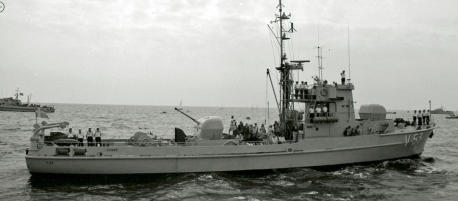
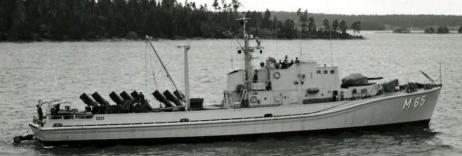

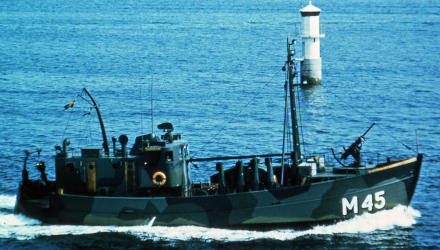
Gåssten class minesweeper:
The Gåssten class fishing boat minesweepers were
3 in number and built of wood (not HMS Viksten).
Their purpose was to train crews for service on board
trawlers modified for minesweeping upon
mobilization. The ships' pennant numbers were M31 -
M33 and were delivered to the Navy in 1973 - 1974.
The purpose was to replace the older fishing
minesweepers HMS Orust and HMS Tjörn.
The first two ships, HMS Gåssten and HMS Norsten, had
conventional wooden hulls of the side trawler type,
while the third ship, HMS Viksten, was constructed with
a plastic hull of the stern trawler type, a frameless
sandwich hull. HMS Viksten was the first full-scale
plastic ship to be built in Sweden.
Although the Viksten was slightly longer but had the
same machinery, the displacement was still less for
Viksten compared to the Gåssten and Norsten which
were built of wood.
The image shows the minesweeper HMS Norsten
M32 of the fishing boat type, launched in 1973,
delivered to the Navy in 1973. Length 24 m, beam 6.5
m. Photo Lennart Bergqvist, October 1973. Image:
Marinmuseum, ID: V58141.
The vessels in the class:
1.
HMS Gåssten (M31), launched in 1972 and
delivered to the Navy in 1973. Decommissioned
in 1998.
2.
HMS Norsten (M32), launched in 1973 and
delivered to the Navy in 1973. Decommissioned in
1998.
3.
HMS Viksten (M33), launched in 1974 and
delivered to the Navy in 1974. Decommissioned in
2007.
HMS Gåssten and Norsten were 24 m long and their
beam were 6.5 m. Displacement 135 tons. Speed: 10
knots. Complement: 11 men. HMS Viksten was 25.3 m
long and its beam was 6.5 m. Displacement 115 tons.
Speed: 11 knots. Complement: 11 men.
The machinery consisted of two Scania-Vabis DS10
diesel engines of 460 hp. 2 propellers. During the
1990s the two diesel engines were replaced by a 440
hp diesel engine to reduce the noise signature.
The armament was a 20 mm anti-aircraft automatic
gun m/40.
The image shows the minesweeper HMS Viksten M33
of the fishing boat type, launched in 1974, delivered to
the Navy in 1974. Length 25.3 m, beam 6.5 m. Photo
Erling Klintefors. Image: Marinmuseum, ID: MM.V
01676.









